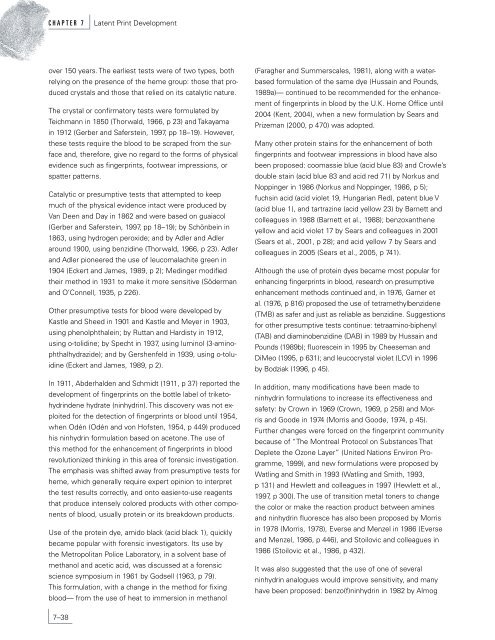Latent Print Development - National Criminal Justice Reference ...
Latent Print Development - National Criminal Justice Reference ...
Latent Print Development - National Criminal Justice Reference ...
You also want an ePaper? Increase the reach of your titles
YUMPU automatically turns print PDFs into web optimized ePapers that Google loves.
C H A P T E R 7 <strong>Latent</strong> <strong>Print</strong> <strong>Development</strong><br />
over 150 years. The earliest tests were of two types, both<br />
relying on the presence of the heme group: those that pro-<br />
duced crystals and those that relied on its catalytic nature.<br />
The crystal or confirmatory tests were formulated by<br />
Teichmann in 1850 (Thorwald, 1966, p 23) and Takayama<br />
in 1912 (Gerber and Saferstein, 1997, pp 18–19). However,<br />
these tests require the blood to be scraped from the sur-<br />
face and, therefore, give no regard to the forms of physical<br />
evidence such as fingerprints, footwear impressions, or<br />
spatter patterns.<br />
Catalytic or presumptive tests that attempted to keep<br />
much of the physical evidence intact were produced by<br />
Van Deen and Day in 1862 and were based on guaiacol<br />
(Gerber and Saferstein, 1997, pp 18–19); by Schönbein in<br />
1863, using hydrogen peroxide; and by Adler and Adler<br />
around 1900, using benzidine (Thorwald, 1966, p 23). Adler<br />
and Adler pioneered the use of leucomalachite green in<br />
1904 (Eckert and James, 1989, p 2); Medinger modified<br />
their method in 1931 to make it more sensitive (Söderman<br />
and O’Connell, 1935, p 226).<br />
Other presumptive tests for blood were developed by<br />
Kastle and Sheed in 1901 and Kastle and Meyer in 1903,<br />
using phenolphthalein; by Ruttan and Hardisty in 1912,<br />
using o-tolidine; by Specht in 1937, using luminol (3-amino-<br />
phthalhydrazide); and by Gershenfeld in 1939, using o-tolu-<br />
idine (Eckert and James, 1989, p 2).<br />
In 1911, Abderhalden and Schmidt (1911, p 37) reported the<br />
development of fingerprints on the bottle label of triketo-<br />
hydrindene hydrate (ninhydrin). This discovery was not ex-<br />
ploited for the detection of fingerprints or blood until 1954,<br />
when Odén (Odén and von Hofsten, 1954, p 449) produced<br />
his ninhydrin formulation based on acetone. The use of<br />
this method for the enhancement of fingerprints in blood<br />
revolutionized thinking in this area of forensic investigation.<br />
The emphasis was shifted away from presumptive tests for<br />
heme, which generally require expert opinion to interpret<br />
the test results correctly, and onto easier-to-use reagents<br />
that produce intensely colored products with other compo-<br />
nents of blood, usually protein or its breakdown products.<br />
Use of the protein dye, amido black (acid black 1), quickly<br />
became popular with forensic investigators. Its use by<br />
the Metropolitan Police Laboratory, in a solvent base of<br />
methanol and acetic acid, was discussed at a forensic<br />
science symposium in 1961 by Godsell (1963, p 79).<br />
This formulation, with a change in the method for fixing<br />
blood— from the use of heat to immersion in methanol<br />
7–38<br />
(Faragher and Summerscales, 1981), along with a water-<br />
based formulation of the same dye (Hussain and Pounds,<br />
1989a)— continued to be recommended for the enhance-<br />
ment of fingerprints in blood by the U.K. Home Office until<br />
2004 (Kent, 2004), when a new formulation by Sears and<br />
Prizeman (2000, p 470) was adopted.<br />
Many other protein stains for the enhancement of both<br />
fingerprints and footwear impressions in blood have also<br />
been proposed: coomassie blue (acid blue 83) and Crowle’s<br />
double stain (acid blue 83 and acid red 71) by Norkus and<br />
Noppinger in 1986 (Norkus and Noppinger, 1986, p 5);<br />
fuchsin acid (acid violet 19, Hungarian Red), patent blue V<br />
(acid blue 1), and tartrazine (acid yellow 23) by Barnett and<br />
colleagues in 1988 (Barnett et al., 1988); benzoxanthene<br />
yellow and acid violet 17 by Sears and colleagues in 2001<br />
(Sears et al., 2001, p 28); and acid yellow 7 by Sears and<br />
colleagues in 2005 (Sears et al., 2005, p 741).<br />
Although the use of protein dyes became most popular for<br />
enhancing fingerprints in blood, research on presumptive<br />
enhancement methods continued and, in 1976, Garner et<br />
al. (1976, p 816) proposed the use of tetramethylbenzidene<br />
(TMB) as safer and just as reliable as benzidine. Suggestions<br />
for other presumptive tests continue: tetraamino-biphenyl<br />
(TAB) and diaminobenzidine (DAB) in 1989 by Hussain and<br />
Pounds (1989b); fluorescein in 1995 by Cheeseman and<br />
DiMeo (1995, p 631); and leucocrystal violet (LCV) in 1996<br />
by Bodziak (1996, p 45).<br />
In addition, many modifications have been made to<br />
ninhydrin formulations to increase its effectiveness and<br />
safety: by Crown in 1969 (Crown, 1969, p 258) and Mor-<br />
ris and Goode in 1974 (Morris and Goode, 1974, p 45).<br />
Further changes were forced on the fingerprint community<br />
because of “The Montreal Protocol on Substances That<br />
Deplete the Ozone Layer” (United Nations Environ Pro-<br />
gramme, 1999), and new formulations were proposed by<br />
Watling and Smith in 1993 (Watling and Smith, 1993,<br />
p 131) and Hewlett and colleagues in 1997 (Hewlett et al.,<br />
1997, p 300). The use of transition metal toners to change<br />
the color or make the reaction product between amines<br />
and ninhydrin fluoresce has also been proposed by Morris<br />
in 1978 (Morris, 1978), Everse and Menzel in 1986 (Everse<br />
and Menzel, 1986, p 446), and Stoilovic and colleagues in<br />
1986 (Stoilovic et al., 1986, p 432).<br />
It was also suggested that the use of one of several<br />
ninhydrin analogues would improve sensitivity, and many<br />
have been proposed: benzo(f)ninhydrin in 1982 by Almog

















